#laravel sorting
Explore tagged Tumblr posts
Text
SysNotes devlog 1
Hiya! We're a web developer by trade and we wanted to build ourselves a web-app to manage our system and to get to know each other better. We thought it would be fun to make a sort of a devlog on this blog to show off the development! The working title of this project is SysNotes (but better ideas are welcome!)

What SysNotes is✅:
A place to store profiles of all of our parts
A tool to figure out who is in front
A way to explore our inner world
A private chat similar to PluralKit
A way to combine info about our system with info about our OCs etc as an all-encompassing "brain-world" management system
A personal and tailor-made tool made for our needs
What SysNotes is not❌:
A fronting tracker (we see no need for it in our system)
A social media where users can interact (but we're open to make it so if people are interested)
A public platform that can be used by others (we don't have much experience actually hosting web-apps, but will consider it if there is enough interest!)
An offline app
So if this sounds interesting to you, you can find the first devlog below the cut (it's a long one!):
(I have used word highlighting and emojis as it helps me read large chunks of text, I hope it's alright with y'all!)
Tech stack & setup (feel free to skip if you don't care!)
The project is set up using:
Database: MySQL 8.4.3
Language: PHP 8.3
Framework: Laravel 10 with Breeze (authentication and user accounts) and Livewire 3 (front end integration)
Styling: Tailwind v4
I tried to set up Laragon to easily run the backend, but I ran into issues so I'm just running "php artisan serve" for now and using Laragon to run the DB. Also I'm compiling styles in real time with "npm run dev". Speaking of the DB, I just migrated the default auth tables for now. I will be making app-related DB tables in the next devlog. The awesome thing about Laravel is its Breeze starter kit, which gives you fully functioning authentication and basic account management out of the box, as well as optional Livewire to integrate server-side processing into HTML in the sexiest way. This means that I could get all the boring stuff out of the way with one terminal command. Win!
Styling and layout (for the UI nerds - you can skip this too!)
I changed the default accent color from purple to orange (personal preference) and used an emoji as a placeholder for the logo. I actually kinda like the emoji AS a logo so I might keep it.
Laravel Breeze came with a basic dashboard page, which I expanded with a few containers for the different sections of the page. I made use of the components that come with Breeze to reuse code for buttons etc throughout the code, and made new components as the need arose. Man, I love clean code 😌
I liked the dotted default Laravel page background, so I added it to the dashboard to create the look of a bullet journal. I like the journal-type visuals for this project as it goes with the theme of a notebook/file. I found the code for it here.
I also added some placeholder menu items for the pages that I would like to have in the app - Profile, (Inner) World, Front Decider, and Chat.

i ran into an issue dynamically building Tailwind classes such as class="bg-{{$activeStatus['color']}}-400" - turns out dynamically-created classes aren't supported, even if they're constructed in the component rather than the blade file. You learn something new every day huh…

Also, coming from Tailwind v3, "ps-*" and "pe-*" were confusing to get used to since my muscle memory is "pl-*" and "pr-*" 😂
Feature 1: Profiles page - proof of concept
This is a page where each alter's profiles will be displayed. You can switch between the profiles by clicking on each person's name. The current profile is highlighted in the list using a pale orange colour.

The logic for the profiles functionality uses a Livewire component called Profiles, which loads profile data and passes it into the blade view to be displayed. It also handles logic such as switching between the profiles and formatting data. Currently, the data is hardcoded into the component using an associative array, but I will be converting it to use the database in the next devlog.

New profile (TBC)
You will be able to create new profiles on the same page (this is yet to be implemented). My vision is that the New Alter form will unfold under the button, and fold back up again once the form has been submitted.
Alter name, pronouns, status
The most interesting component here is the status, which is currently set to a hardcoded list of "active", "dormant", and "unknown". However, I envision this to be a customisable list where I can add new statuses to the list from a settings menu (yet to be implemented).




Alter image
I wanted the folder that contained alter images and other assets to be outside of my Laravel project, in the Pictures folder of my operating system. I wanted to do this so that I can back up the assets folder whenever I back up my Pictures folder lol (not for adding/deleting the files - this all happens through the app to maintain data integrity!). However, I learned that Laravel does not support that and it will not be able to see my files because they are external. I found a workaround by using symbolic links (symlinks) 🔗. Basically, they allow to have one folder of identical contents in more than one place. I ran "mklink /D [external path] [internal path]" to create the symlink between my Pictures folder and Laravel's internal assets folder, so that any files that I add to my Pictures folder automatically copy over to Laravel's folder. I changed a couple lines in filesystems.php to point to the symlinked folder:

And I was also getting a "404 file not found" error - I think the issue was because the port wasn't originally specified. I changed the base app URL to the localhost IP address in .env:

…And after all this messing around, it works!
(My Pictures folder)

(My Laravel storage)

(And here is Alice's photo displayed - dw I DO know Ibuki's actual name)

Alter description and history
The description and history fields support HTML, so I can format these fields however I like, and add custom features like tables and bullet point lists.

This is done by using blade's HTML preservation tags "{!! !!}" as opposed to the plain text tags "{{ }}".
(Here I define Alice's description contents)


(And here I insert them into the template)

Traits, likes, dislikes, front triggers
These are saved as separate lists and rendered as fun badges. These will be used in the Front Decider (anyone has a better name for it?? 🤔) tool to help me identify which alter "I" am as it's a big struggle for us. Front Decider will work similar to FlowCharty.

What next?
There's lots more things I want to do with SysNotes! But I will take it one step at a time - here is the plan for the next devlog:
Setting up database tables for the profile data
Adding the "New Profile" form so I can create alters from within the app
Adding ability to edit each field on the profile
I tried my best to explain my work process in a way that wold somewhat make sense to non-coders - if you have any feedback for the future format of these devlogs, let me know!
~~~~~~~~~~~~~~~~~~
Disclaimers:
I have not used AI in the making of this app and I do NOT support the Vibe Coding mind virus that is currently on the loose. Programming is a form of art, and I will defend manual coding until the day I die.
Any alter data found in the screenshots is dummy data that does not represent our actual system.
I will not be making the code publicly available until it is a bit more fleshed out, this so far is just a trial for a concept I had bouncing around my head over the weekend.
We are SYSCOURSE NEUTRAL! Please don't start fights under this post
#sysnotes devlog#plurality#plural system#did#osdd#programming#whoever is fronting is typing like a millenial i am so sorry#also when i say “i” its because i'm not sure who fronted this entire time!#our syskid came up with the idea but i can't feel them so who knows who actually coded it#this is why we need the front decider tool lol
24 notes
·
View notes
Text
webdev log uhhhh... 6?
Haven't worked on my site in a bit because I think I fucked up somewhere in during the deployment phase so now it's hard to host it locally.... only the index page works and the css is half broken anyways, presumably because of laravel breeze's tailwind coming preinstalled. I DID have to jump through hoops to get it going during deployment.. just don't know which hoops so it's stuck that way >_>;; so now I can't host it locally for development......... I'll have to make things and just hope it shows up when I deploy them I think
Failed to listen on 127.0.0.1:8000 (reason: ?)
cool, cool. thanks. very helpful debugging message..
anyways, coded up a little php doohicky and updated my site! WANNA PEEK?
I wanted to migrate my fridge page (art others have done of my characters) to my site, but I didn't want to implement another table because YUCK I'm so done with that.
I wanted something more automatic because I'm lazy and I also wanted it to not look like it's from 2003 like my neocities to match with my new site. too much trouble!!!! including the stuff previously mentioned.. so I left it untouched for a while.
then I was talking with someone and wanted to try making this with php.....

it's pretty basic. finished the code for the script in like an hour maybe, and then later it was mostly just tinkering with the html/css itself to make it display all nice and grid-like.
all it does is take all images from a specified folder and spits them out.
it creates a DirectoryIterator object to iterate through the specified folder (at least, I think that's how DirectoryIterator works.... dunno) then for each individual file it checks if it's an image, gets the time the file was modified, then stores the file path and modified time in an array. then that array gets sorted via modified time (newest first), and then iterated through and BAM...
I'd prefer a better time system such as organize when the file was actually created, but if you paste a file into a new folder, "created time" gets changed to when you pasted it.. using file modified time is the only way when you aren't using a database and just want this to be all done automatically I think. unless I'M STUPID and someone has a better idea.. then please enlighten me.
ANYWAYS added The Fridge to my site using my lil code! :>

updated my About to include a link too...
also, I was looking up things and found this funny example code on stack overflow

let's all randomize our racism images.....
6 notes
·
View notes
Text
Ultimate Guide to eCommerce Website Development in 2025: Features, Tech Stack & Best Practices

The world of online shopping is evolving rapidly. In 2025, having a high-performing, customer-centric eCommerce website isn’t just a bonus — it’s a necessity. Whether you’re launching a new online store or upgrading an existing one, working with an expert eCommerce website development company can set you up for long-term success.
This guide shares everything you need to know — from essential features to the right tech stack — and why choosing the best eCommerce website development company can make all the difference.
💡 What is eCommerce Website Development?
eCommerce website development is the process of building a robust online store where products or services can be searched, filtered, and purchased seamlessly. Whether you’re in fashion, electronics, or even looking into jewellery website development, the development process includes:
Front-end design and UX
Back-end logic, inventory, and checkout
Payment gateway integration
Third-party APIs (shipping, CRM, ERP)
If you’re planning a niche-specific platform like jewellery website development, features like dynamic gold rate integration, virtual try-ons, and private pricing catalogs are often critical.
🔑 Key Features of a Successful eCommerce Website
To stand out in 2025, your eCommerce site — whether general or niche like jewellery website development — must offer:
1. Dynamic Product Catalog
Real-time inventory updates
Bulk uploads & categorization
Private/public segmentation for B2B/B2C
2. Mobile-First Responsive Design
With mobile commerce dominating, the best eCommerce website development company always prioritizes responsive, mobile-friendly design.
3. Advanced Filtering & Search
Sort by material, price, availability, brand
For jewellery sites, add filters like purity (22K/18K), stone type, and weight
4. Personalized User Experience
AI-based product recommendations
Customer-specific pricing (vital for B2B and luxury niches like jewelry)
5. Secure Checkout & Payments
Top eCommerce website development companies ensure secure payment integration with UPI, cards, wallets, and buy-now-pay-later options.
6. ERP & CRM Integration
Real-time stock sync
Order & customer lifecycle tracking
Essential for high-volume sellers or complex inventory like in jewellery website development
7. WhatsApp & SMS Notifications
Order confirmation, shipping alerts, new arrivals
A feature many clients request when working with a jewellery website development expert
8. Loyalty & Rewards
Ideal for increasing repeat purchases
Works well across industries including jewellery
⚙️ Tech Stack: What Should You Use?
Choosing the right tech stack is one of the most critical steps in eCommerce website development. A professional eCommerce website development company will evaluate your business model, expected traffic, product complexity, and growth plans to recommend the best technologies. For the frontend, modern frameworks like React.js or Next.js paired with Tailwind CSS ensure fast, responsive, and mobile-first design. On the backend, scalable and secure platforms like Node.js, Laravel, or Django are often used to handle dynamic business logic and database operations. When it comes to managing content, headless CMS options such as Strapi or Sanity allow for flexible and fast content delivery. Databases like PostgreSQL or MongoDB are chosen based on the need for relational or NoSQL data structures. Hosting is typically managed through platforms like Vercel, AWS, or DigitalOcean to ensure speed and uptime. For payment processing, secure integrations with Razorpay, Stripe, or PayPal are a must. Finally, tools like Google Analytics 4 and Hotjar are used for monitoring user behavior and optimizing performance. When building niche-specific platforms — such as those involving jewellery website development — your development partner must be able to integrate features like real-time metal pricing, visual try-ons, and private catalogs. The best eCommerce website development company will always tailor the tech stack to meet these unique needs while keeping the platform scalable and secure.
🎯 Best Practices for eCommerce Success
Here’s what leading eCommerce website development companies recommend for optimal performance:
Design for trust with SSL and security badges
Optimize load times (<2 seconds)
Use rich media (images, 360° views, videos)
Simplify checkout with guest access and minimal steps
Implement structured data for better search visibility
Use retargeting tools to reduce abandoned carts
For example, if you’re managing a jewellery website, trust, product clarity, and fast performance are non-negotiable.
💰 Cost & Timeline Estimates
The cost and timeline for developing an eCommerce website can vary significantly depending on the size, features, and complexity of the project. A basic eCommerce website, with essential product listings and checkout functionality, can typically cost between $2,000 to $5,000 and be completed within 2 to 4 weeks. Mid-range stores with more advanced features like ERP integration, custom filters, loyalty programs, and responsive design may cost between $5,000 and $15,000, requiring around 1 to 2 months of development time. If you’re planning to build a high-end or specialized platform — such as a jewellery website development project featuring dynamic gold rates, product personalization, and WhatsApp notifications — the investment may range from $15,000 to $50,000 or more, and the timeline could stretch from 3 to 6 months, depending on complexity. Choosing the best eCommerce website development company ensures that you’re not only getting a cost-effective solution but also one that delivers long-term value through performance, scalability, and ongoing support. Keep in mind that maintenance, security, and marketing costs post-launch are also vital to factor into your overall budget.
🚀 Final Tips to Launch with Impact
Partner with the right eCommerce website development company that understands your industry
Conduct rigorous testing on mobile, desktop, and across browsers
Plan a strong launch strategy — SEO, email marketing, and influencer tie-ins
Iterate continuously based on real customer behavior and heatmaps
✅ Conclusion
Whether you’re building a general retail store or a niche-specific platform like a jewellery website, the success of your eCommerce journey depends on strong foundations — technology, design, and functionality. Choosing the best eCommerce website development company ensures your site is not only beautiful but also fast, secure, and conversion-optimized.
Looking to start your eCommerce journey the right way? Partner with a trusted eCommerce website development company that understands your vision, your customers, and your growth potential.
0 notes
Text
What is PHP Framework?

A PHP framework is a platform to build PHP web applications. PHP frameworks provide libraries for commonly used functions, which helps to cut down on the amount of original code developers need to write from scratch. A PHP framework provides a basic foundation for the development of web applications in PHP.
According to Wikipedia, there are over 40 PHP frameworks, each with its own set of features and particularities. Some of them cater to beginners, offering simplicity and ease of use, while others target developers looking for robust testing or sophisticated package management capabilities.
In PHP, there are several frameworks available that make it easy to create REST APIs, including Laravel, Slim, and Lumen. These frameworks provide a range of features and libraries to help developers create APIs quickly and efficiently, including support for routing, request and response handling, and data validation.
This course at TCCI is just awesome. You will learn the basics and then you will jump to making your own CMS.
TCCI Computer Coaching Institute located in Bopal and Iskon Ambli road in Ahmedabad. We educate distinctive sort of Programming Languages likeC, C++, Java, Python, Database Management, Python, Data Structure,HTML, CSS, JavaScript, .Net , PHP, System Programming, Compiler Design, Boot Strap, Angular Js and so on. Lectures conducted as per students’ flexible time.
To connect with us
Call us @ 98256 18292
Visit us @ http://tccicomputercoaching.com/
#TCCI computer coaching institute#best computer classes near me#best PHP classes near thaltej ahmedabad#best computer class in Bopal Ahmedabad#best computer class in iscon-ambli road-ahmedabad
0 notes
Text
7 Programming Languages for Web Development

Introduction:
In today’s fast-changing world of web development, picking the right programming language is crucial. There are so many options available that one may easily become overwhelmed. But don’t worry! We’re here to help you navigate through the top 7 programming languages for web development. Each language has its advantages and uses, so let’s dive in and explore them together.
When it comes to web development, one of the most popular choices is JavaScript. It’s like the Swiss Army knife of web languages, versatile and powerful. With JavaScript, you can create interactive and dynamic content for your websites or web applications. Plus, there’s a whole bunch of libraries and frameworks available, making it easier to build whatever you need. So, if you want to add some cool features or make your site more engaging.
Summary
1. JavaScript: The Swiss Army Knife of the Web
2. Python: A Serene Path to Web Development Bliss
3. C#: Empowering Web Development with .NET
4. PHP: Fueling the Web’s Backend
5. C++: Unleashing the Power of Performance
6. Go: Simplifying Web Development with Efficiency
7. Ruby: Embracing Simplicity with Rails
1. JavaScript: The Swiss Army Knife of the Web

JavaScript is like the superhero of web development, making websites super fun and interactive. It’s the go-to language for creating cool stuff on the web, from making forms that talk back to you to adding exciting animations that catch your eye.
The best part? JavaScript is not picky. It’s not just good at making things look awesome on the outside; it’s also a multitasker. With platforms like Node.js, it can handle the heavy lifting behind the scenes, making it easier for developers. So, whether you’re a web pro or just starting, JavaScript is the friendly sidekick you need to make your web projects shine.
2. Python: A Serene Path to Web Development Bliss
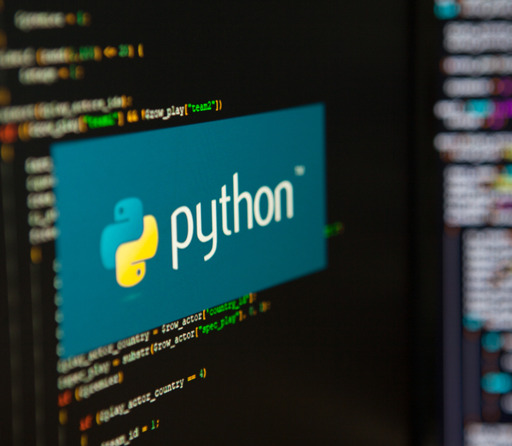
Python is like a cozy blanket on a chilly day, wrapping developers in comfort and ease. It’s loved by folks in all sorts of fields, including web development because it’s just so darn friendly. With tools like Django and Flask, Python makes building websites and apps feel like a breeze.
What’s neat about Python is how simple it is to understand. Its clean and clear syntax makes it a joy to work with, even for beginners. Plus, there’s a whole bunch of extra goodies (we call them packages) that you can use to make your projects even cooler. Whether you’re crunching data or teaching computers to think, Python’s got your back, making web development feel like a walk in the park.
3. C#: Empowering Web Development with .NET

C# is like a trusty toolbelt for web developers, ready to tackle any challenge that comes their way. Developed by the smart folks at Microsoft, C# has become a go-to language for building all sorts of cool stuff on the web. With handy tools like ASP.NET Core, C# makes it easy to create web applications that are not only fast and powerful but also super secure.
What’s neat about C# is how it plays well with other Microsoft technologies. Whether you’re working on big projects for a fancy company or just tinkering with ideas in your garage, C# has all the tools you need to make your dreams a reality. So, if you’re part of the Microsoft club, C# is your secret weapon for making awesome things happen on the web.
4. PHP: Fueling the Web's Backend

PHP is like the dependable engine under the hood of the web, quietly powering all sorts of amazing things. It’s been around for ages, and good reason – it’s simple, flexible, and gets the job done. With frameworks like Laravel, Symfony, and CodeIgniter, PHP gives developers the tools they need to build all kinds of cool web stuff, from online stores to blogging platforms.
One of the best things about PHP is its huge community of developers who are always ready to lend a helping hand. Plus, it plays nice with just about everything – whether you’re using Apache or Nginx, MySQL or PostgreSQL, PHP can handle it all. So, if you’re looking to dive into web development and want a language that’s tried and true, PHP is your ticket to success.
5. C++: Unleashing the Power of Performance

C++ might not be the first language that comes to mind when you think about web development, but it’s like a hidden gem waiting to be discovered. It’s known for its lightning-fast speed and efficiency, making it perfect for those times when every millisecond counts. With a ton of ready-made tools and support for different programming styles, C++ gives developers the freedom to create supercharged web applications that run like a dream.
Sure, learning C++ might take a bit more time and effort compared to other languages, but the payoff is worth it. Once you’ve got the hang of it, you’ll have the power to create web solutions that can handle even the most demanding tasks, whether it’s powering immersive online games or crunching numbers for financial trading. So, if you’re up for a challenge and want to take your web development skills to the next level, C++ is the language for you.
6. Go: Simplifying Web Development with Efficiency

Go, also known as Golang, is like the cool new kid on the block in the world of web development. It’s been making waves lately for its simplicity and efficiency, making it a favorite among developers who want to get stuff done without all the fuss. Developed by the folks at Google, Go offers a fresh take on programming languages, focusing on making things easy to understand and work with.
One of the best things about Go is its built-in support for concurrency, which means you can do lots of things at once without breaking a sweat. Plus, its simple syntax makes it a breeze to write clean and readable code, even for beginners. Whether you’re building tiny services or big web servers, Go’s got your back with its lightweight and powerful features. So, if you’re looking for a language that’s both easy to learn and powerful to use, Go is the way to go.
7. Ruby: Embracing Simplicity with Rails

Ruby on Rails, or simply Rails, is like the best friend you never knew you needed in web development. It’s become super popular among developers for its simplicity and speed, making it a go-to choice for building all sorts of cool web stuff. With its clean and elegant syntax, Rails makes writing code feel like a breeze, even for those new to programming.
One of the coolest things about Rails is how it takes care of all the boring stuff for you. Instead of wasting time setting up configurations, Rails lets you dive right into building your application. This means you can focus on what matters – creating awesome features and bringing your ideas to life. So, whether you’re a startup looking to make it big or a seasoned developer looking for a change, Rails is the perfect tool to help you build something amazing on the web.
FAQs
Q.1. Which programming language is best for web development?
A.1. The best programming language for web development depends on various factors such as project requirements, developer expertise, and scalability needs. However, popular choices include JavaScript, Python, and Ruby for their versatility and robust frameworks.
Q.2. Is C++ suitable for web development?
A.2. While not commonly associated with web development, C++ can be used for certain web applications, particularly those requiring high-performance and low-level control. C++ is well-suited for tasks such as gaming, real-time simulations, and high-frequency trading.
Q.3. What are the advantages of using Go for web development?
A.3. Go offers several advantages for web development, including simplicity, concurrency support, and efficient performance. Its minimalist syntax and robust standard library make it ideal for building fast and reliable web applications, particularly microservices and APIs.
Q.4. How does C# integrate with web development NET?
A.4. C# integrates with web development through the .NET framework, providing tools like ASP.NET Core for building high-performance web applications. With seamless integration with other Microsoft technologies, C# enables developers to create scalable and maintainable web solutions.
Q.5. Why is Ruby on Rails popular among web developers?
A.5. Ruby on Rails, or Rails, is popular among web developers for its elegant syntax, developer-friendly conventions, and rapid development capabilities. With its emphasis on convention over configuration, Rails streamlines the development process and encourages best practices, making it an attractive choice for web development projects.
Conclusion
In the world of web development, picking the right programming language is crucial for success. With many options available, developers need to choose a language that fits well with their project, team skills, and plans. Each language has its features and advantages, suitable for different needs like quick project building or handling complex tasks. By knowing the strengths and weaknesses of each language, developers can use them to create creative and effective web solutions. It’s all about finding the right tool for the job!
We appreciate you taking the time to go through our article. If you need more details, please explore our website at https://srutatech.com or get in touch with us directly at +1-215-650-3185. Our team is eager to assist you with any inquiries you may have!
0 notes
Text
Laravel Testing: A Developer's Gateway to Code Quality
Within the domain of advanced web improvement, guaranteeing the unwavering quality and steadiness of your application is foremost. One of the key instruments in a developer's arsenal to attain this can be a strong testing technique.
Laravel, a well-known PHP web system, comes equipped with a capable and expressive testing environment that enables designers to easily write tests for their applications. In this article, we'll dig into the world of Laravel testing, investigating its benefits, techniques, and best practices, and highlighting why it's essential to hire Laravel developers for seamless application development.
Why Testing Things:
Early Bug Location:
Testing permits engineers to capture bugs and issues early in the advancement process. By composing tests in nearby code, designers can distinguish and settle issues that, some time ago, were more complex and expensive to resolve.
Code Certainty:
A well-tested application ingrains certainty in designers. Knowing that changes won't accidentally break existing usefulness gives a sense of security when executing modern highlights or refactoring code.
Improved Collaboration:
Tests serve as documentation for your code. They give clear examples of how your code is aiming to be utilized, making it less demanding for other designers to get it and contribute to the venture.
Laravel Testing Nuts and Bolts:
Laravel underlies different sorts of tests, including counting unit tests and browser tests. Let's explore each of them:
Unit Tests:
Unit tests center on a little, confined piece of code, ordinarily a single strategy or work. Laravel's testing environment provides devices like PHPUnit for composing and executing these tests. Unit tests guarantee that the components of your application work as anticipated.
Include Tests:
Highlight tests look at the usefulness of a larger parcel of your application, regularly mimicking a user's interaction with the framework. Laravel's testing suite permits engineers to form HTTP demands and declare the anticipated results, empowering comprehensive testing of courses, controllers, and more.
Browser Tests:
Laravel Nightfall, a browser robotization and testing apparatus, facilitates writing tests that are associated with your application through a browser. This permits end-to-end testing, guaranteeing that your application carries on accurately from the user's viewpoint.
Setting Up Laravel Testing:
Environment Setup:
Laravel provides a devoted testing environment, permitting you to design database connections, caching, and other settings, particularly for testing. This guarantees that tests run reliably and freely in your generation's environment.
Test Database:
Laravel's testing environment comes with an isolated database arrangement, avoiding tests from the interferometer along with your live data. The system gives helpful instruments to emigrate and seed the test database, guaranteeing a clean and surprising state for testing.
Best Hones for Laravel Testing:
Test-Driven Improvement (TDD):
TDD may be a development approach in which tests are composed of genuine code from some time ago. This technique guarantees that your codebase is tried from the start, advancing a more solid application.
Separation and Reliance Infusion:
Tests ought to be disconnected from each other, meaning that the outcome of one test ought to not influence another. Laravel's dependency infusion and deriding capabilities make it simple to confine components and test them in segregation.
Nonstop Integration (CI):
Integrated testing into your improvement workflow through CI apparatuses like Travis CI or GitHub Activities. Computerized testing on each code thrust makes a difference, captures issues early, and guarantees a steady and dependable codebase.
Conclusion:
Laravel testing may be a portal to achieving code quality and building versatile web applications. By adopting testing hones, designers can make more viable code, diminish bugs, and foster collaboration inside improvement groups. Whether you are a seasoned Laravel designer or just beginning your journey, incorporating testing into your workflow will undoubtedly lead to more dependable and adaptable applications. Grasp the control of Laravel testing and lift the quality of your code to modern standards.
1 note
·
View note
Text
Choose the Best Laravel Framework for Your Website with Our Top-Tier Services in 2024
In the fast-paced digital landscape, choosing the right framework for website development is pivotal. Laravel has come up as a standout choice, and in this blog, we'll explore why it's considered the best in the industry. Join us on a journey through the world of Laravel website development, as we navigate the features and benefits that make it exceptional. And, to guide us through this exploration, we have the expertise of a top website development company.
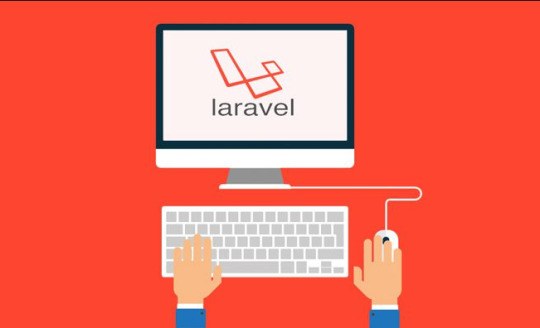
What is Laravel Used for?
Laravel is a fantastic tool for building websites and web applications, designed to make the lives of developers easier. Think of it like a superhero for web development! Here's why people love using Laravel in simple terms:
Building Cool Websites: Laravel is like a magic wand for developers. It helps them create all sorts of websites – from basic ones like blogs to fancy ones with lots of features.
Keeping Things Organized: Imagine you're cleaning your room, and everything has its place. That's what Laravel does with code. It is simple for developers to find and manage their code without any hassle.
Talking to Databases: Laravel has smart and expressive ways to talk to databases without making developers write complicated messages. Websites often need to talk to databases, which are like digital storage rooms for information.
User Logins and Permissions: If you ever used a website where you had to create an account, that's where Laravel's superpowers come in. It makes sure only the right people have access to certain parts of the website.
Decorating Web Pages: Making web pages look nice is important, right? Laravel has something called Blade, which is like a design toolkit. It helps developers make web pages look awesome without spending hours and hours.
Making Web Traffic Flow Smoothly: Laravel makes building websites fun, organized, and way less stressful. By making sure they don't get lost it helps set clear paths for people to follow. So, when you are browsing a cool website, there's a good chance Laravel played a role.
Is Laravel frontend or backend?
Laravel website development is like the wizard behind the curtain that makes a website work smoothly. When we talk about Laravel, we are referring to the process of using it, a powerful tool or framework, to create and organize the essential parts of a website. Laravel takes care of various tasks, like talking to the database, managing user logins and permissions, and handling the overall structure of the website. It follows MVC (Model-View-Controller) to keep things organized – it's like having different departments in a company, each doing its specific job.
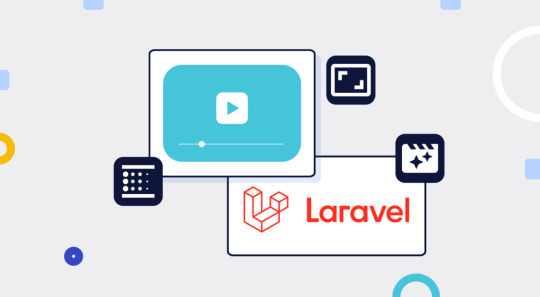
But wait, there's more! Laravel also has a sidekick called Artisan, a superhero assistant for developers. Artisan helps with repetitive tasks, making the whole process smoother and faster. While Laravel focuses on the back-end, it often partners with front-end technologies (HTML, CSS, and JavaScript) to create the complete website experience. It's like having a dynamic duo – Laravel ensures everything runs flawlessly behind the scenes, while the front-end takes care of what users see and interact with. It makes your online experience enjoyable and hassle-free.
Let’s Know a Few Benefits of Using Laravel for Web Development
It offers numerous advantages for web developers, making it a preferred choice for web application development. Here are some key advantages of Laravel:
Elegant Syntax: Laravel features a clean and expressive syntax that makes coding enjoyable and efficient. The readability of the code simplifies development and maintenance tasks.
Artisan Console: Developers can use Artisan to perform various tasks such as database migrations, code generation, and more, saving time and effort.
MVC Architecture: Laravel follows the Model-View-Controller (MVC) architectural pattern, providing a clear separation of concerns. This structure makes the codebase organized and easier to maintain.
Security Features: Laravel prioritizes security, providing features such as encryption, hashing, and protection against SQL injection and cross-site scripting attacks. Its built-in authentication system also makes it easier to implement secure user access.
Community Support: It ensures that developers have access to a wealth of resources, tutorials, and packages, by making it easier to troubleshoot issues and stay updated on best practices.
Laravel's advantages lie in its simplicity, robust features, and the ability to streamline the development process. It empowers developers to create scalable, maintainable, and secure web applications with efficiency and ease.
6 Effective Role of a Top Website Development Company
Let's embark on a journey to understand the profound impact and significance these companies bring to the world of web development by exploring some points:
Crafting Custom Solutions: A top website development company acts as a skilled craftsman, and carefully shapes bespoke solutions for each client. By investing time to understand the client's unique requirements and goals, they ensure that the resulting website aligns seamlessly with the client's vision.
Cutting-Edge Technologies: Picture a technological frontier where innovation knows no bounds. These companies stand at the forefront, embracing cutting-edge technologies to ensure the websites they create are not just functional but equipped with the latest features and capabilities.
Our Expertise: Our expertise of a top website development company navigate the complexities of web development with a wealth of experience in their arsenal, by providing invaluable insights and solutions honed by years of practice.
Seamless Integration: Much like a skilled conductor harmonizing various musical instruments, top development companies seamlessly integrate different technologies to create a symphony of functionality.
Ensuring Scalability: Scalability and adaptability are woven into the fabric of their development process, future-proofing the websites they craft. They build websites not just for today but with an eye on the future.
Our Responsive Approach: The flexibility of a top development company is similar to a flexible dancer adapting to the rhythm of change. They possess a responsive approach, swiftly adapting to evolving technologies, client needs, and industry trends.
Conclusion
In conclusion, as we navigate the dynamic landscape of web development in 2024, Laravel emerges as the superhero for crafting robust websites, backed by the expertise of top-tier development companies. Laravel's elegant syntax, security features, and community support make it a standout choice for developers, simplifying the complications of web application development. As businesses strive to establish a robust online presence, the combination of Laravel's capabilities and the finesse of top development companies promises to redefine the standards of web development in 2024 and beyond.
0 notes
Text
As a side note, I kind of like how PHP changed during past 3-4 years. I always used PHP as a sort of mix of Python and Bash in my day-to-day life, and it was also my go-to language for prototyping.
And with all the PHP7+ stuff, ReactPHP, Composer and PSRs, it started to be more and more enjoyable to me.
And I had very little experience with stuff like Laravel or Symfony so far, but they seem to be pretty cool as well.
When I started some of my projects, I used PHP as a language for prototyping, then quickly switched to something else. And my "big" projects that use PHP are just stuck on it because of legacy code.
Now I'm not even sure I would want to change the stack in the future, I kinda like it.
And ReactPHP proved to be pretty stable for async/server apps. Currently have 5 different ones running, some of them for 5+ years almost without stopping, no issues whatsoever.
Well, there were issues in some cases, but these were purely because of my fuckups and the apps were still working fine.
And there were some restarts in this 5 year run, but because I wanted to migrate everything to another node or upgrade the existing one. Stability, speed and memory consumption were never an issue.
Though I never made any performance tests with some real numbers. But at a glance it felt no worse than Node apps really.
And stuff like PXP popping up is great too, adding some TypeScript treatment to the mix.
And there are also ways to merge React.js with PHP, as well as "run" PHP in the browser if you REALLY need it. That seem to be an overkill, but the option is still there, which is awesome.
There are two features I would like to add: operator overload (PXP has this in plans though) and some metaprogramming features from D lang.
0 notes
Text
TOP 10 ADVANTAGES OF USING LARAVEL FRAMEWORK

Laravel is one of the most popular frameworks that offer custom software development. This framework has got the highest stars on Github, which mentions that more than 56000 developers are currently using it across the globe for responsive web development. Based on Github’s report, it’s quite evident that you have ample choices if you want to hire Laravel developer for your online presence.
However, before choosing any framework, it’s essential that you know its pros and cons well. Otherwise, you won’t be able to make the best out of your project. Therefore, we are sharing the top ten advantages of using the Laravel framework for custom software development. Based on these advantages, you can create a plan that aligns with your business goals and your industry niche by discussing it with your Laravel development company
Before we explain the advantages of the Laravel framework to you, here is a snippet of the Laravel framework and its possibilities
What is Laravel and What are its Uses?
Laravel is a free and open-source PHP framework based on MVC architecture that offers effortless web and app development. Taylor Otwell founded this framework, which got released in June 2011. The latest version of the framework is 8.16.1. Laravel is suitable for developing complex and large websites.
Though Laravel is a bit complex as compared to the other PHP frameworks, it is the most suitable one when it comes to developing extremely powerful web applications. Laravel provides expressive tutorials (Laracasts), documentations and boasts a huge community to assist the developers worldwide.
Some of the vital features of the Laravel framework are Bundles, Query Builder, Reverse Routing, Eloquent ORM, Application Logic, IoC, Migrations, Class Auto Loading, Blade Templating Engine, Automatic Pagination and more. The ORM and routing allow one to develop modern applications with sheer perfection.
The Top 10 Advantages of Using Laravel Framework:
1. Fixing Security Vulnerabilities: Be it any web application, the development phase causes some sort of technical glitch that can be a real threat to security vulnerabilities. Some of the most vulnerable elements are cross-site scripting, SQL injection and site request forgery. Laravel can help you secure your web app with its fanatically guarded codebase.
2. Mail Service Integration: Today, it’s essential for businesses to send service emails to the customers after every event, be it registration or purchase. Laravel makes it better for the SwiftMailer library with its simple, clean API to perform the task. Moreover, Laravel can provide drivers for Mailgun, SMTP, SparkPost and a lot more platforms.
3. Authorization Process: For every app, authorization of the users is a common aspect, which makes the owners sure that the users are authentic people. It helps them to secure their purchase options from unauthorised buyers. Laravel’s authentication process is quite advanced and yet simple, which anyone can implement and use with ease.
4. Faster Application: Recent studies show that users prefer fast-loadable and high-responsive apps on every platform. A slow app can be the reason for the loss of revenue for any business and hence, Laravel can provide the best solution. It comes with in-memory caches such as APC and Memcached and also ensures multiple cache configurations.
5. Built with Testing: For any Laravel development company, the process of testing apps is like a cakewalk. Laravel comes with in-built testing features with PHPUnit and hence it offers speedy and error-free testing every time. There are convenient helper methods in this framework that allow expressive testing of complex large apps.
6. Configuration Error: User experience is partially dependent upon the way an app can handle errors. In many apps, users click the Submit button and then errors are identified. It helps the users to understand which steps are taken wrong and should be corrected. For Laravel, error and exception handling are two of its best features.
7. Queue Service: When an app gets more traffic, it has to handle an excessive number of message requests per second. Now, if the app is developed with an ordinary framework, there are chances of data loss or higher expense. With the unified API system of Laravel, there is no reason to worry. The process of sending messages and emails speeds up in this framework.
8. URL Routing Configuration: The users usually use URL links to see something specific such as the service page or a contact form. If the web app doesn’t have URL routing, it won’t be able to show that exact page and instead will show an error. Laravel uses app/Http/routes.php files to identify URL routes and respond quickly to users’ requests.
9. Separation of Codes: If you hire Laravel developer for your business, you will get to know about this advantage in detail. Laravel is an MVC framework, which can separate business logic code from presentation code. As a result, Html Layout Designers do not need to interact with developers while changing the UI/UX of a web page.
10. Task Scheduling: Every web app requires a task scheduling system to track and manage all its ongoing tasks. Earlier, developers had to generate Cron entries to schedule tasks each time but today, Laravel allows the developers to command schedule tasks within the framework and generate a single Cron entry in the server.
If you are planning for a full-stack Laravel app development, therefore, looking for a Laravel development company to partner with, look no further than us. We, Idiosys Technologies, are one of the most eminent web and app development companies providing a plethora of services including Laravel app development. Headquartered in Kolkata, we basically provide web development, app development and marketing solutions to a huge number of multi-national and start-up companies from India, Canada, the USA, Germany, Australia, Brazil, the UK and Panama. Our expertise and long experience in the industry has made us one of the top web development and IT companies in India. You can hire the most efficient Laravel developers’ team and Laravel framework experts from our company to boost your online presence. So, why wait anymore? Contact us today to know the best deals we can offer you.
0 notes
Text
How to Sort Collections in Laravel and PHP
How to Sort Collections in Laravel and PHP
You can use sortBy for laravel collection for sorting by custom orders. You can do like this: $collection = collect($array); $order = [1,2,3,4,5]; $collection->sortBy(function($model) use ($order){ return array_search($model->order_id, $order); } Also, you could add an attribute accessor to your model which does the same. public function getSortedItemsAttribute() { if ( !…
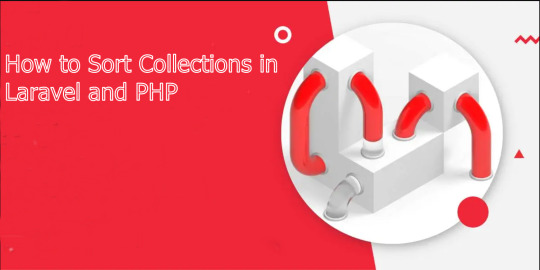
View On WordPress
#laravel 8#laravel collection sorting#laravel sorting#php#sort by custom collection#sort by orderId#sorting#sorting collection in laravel
1 note
·
View note
Text
webdev log 3
this log is longer since I'm writing it as I work, since I forget a lot once I've put down the keyboard for the night (day? I'm always up until morning)
okay, so...
I've implemented user (me)-only add story, edit story, and add chapter, and edit chapter functions


creating a story. I have some "preset" tags. clicking on them adds them to the input, and it'll get converted into arrays to be placed into the database. they're sort of placed there manually since I'm too lazy to make it so that it sifts through tags and posts them there but I'd rather not since some tags are only used once. for the series presets being manually placed there.. well, I have no excuse. I'm just lazy. I'll just kms when I have to add another, ig.
anyways once a new story is made, there's no chapter added so the link to it doesn't work. I have to go in and add a chapter. I will not update this because I don't care and it doesn't trouble me enough to make it a feature so you can upload it all in one go.

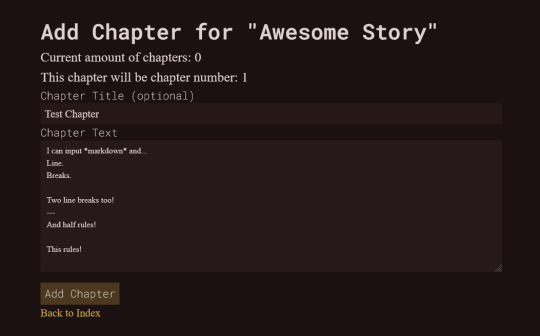
from there I get to see this shitty barebones chapter creator.
START TANGENT feel free to skip
laravel Eloquent stores the text as-is so I won't need to use my shitty markdown -> html converter that I have on my secret utilities site that I always had to use for when posting my stories onto my neocities.
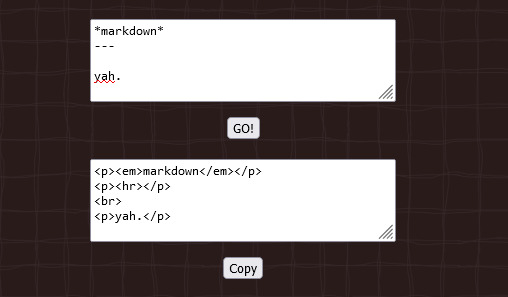
that's what it looked like, lol. I had to make this because of the way I write and I want it to display in a particular way which I'll get into in a sec. the reason why I didn't want to use some shitty markdown -> html converter on some other website is because a single linebreak gets converted to <br> while <p> only gets sandwiched between paragraphs with double line breaks.
I don't like that since I wanted text indents for every <p> but text-indent doesn't apply to the next line within a <p> if you use <br>... they only apply to the start of each <p>. a workaround for this is to use text-indent: {size} each-line; but each-line isn't supported in all browsers, including chrome of all things. So I had to write up a program for my own converter which wraps *every* line into a <p> and applies a <br> if there's another newline after that.
but for my new site, there's a function that detects what browser the user is using and will add the text-indent styling only if using supported browsers. so chrome users will just be indent-less! sorry! (you should switch to firefox anyways)
END TANGENT okay, enough about my neocities..
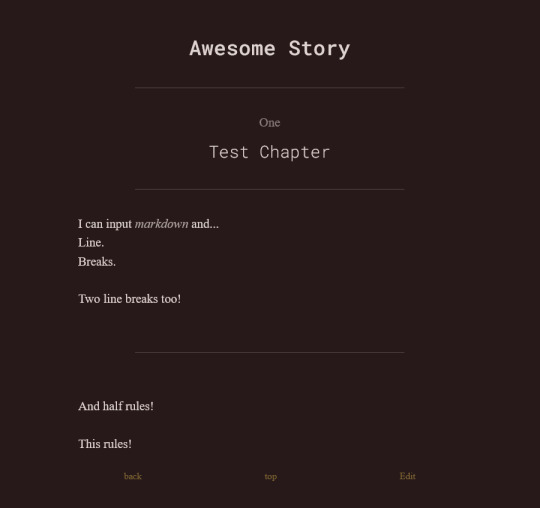
What it looks like for a user (me)... guests won't be able to see the edit link.
When editing, there's an option to delete the chapter. if it is the first chapter of a story, then it will delete the whole story. it's currently the only way to delete a story, mostly as a safeguard for myself since I don't trust myself. if I have to delete a story with a ton chapters in the future... well.. then fuck me.
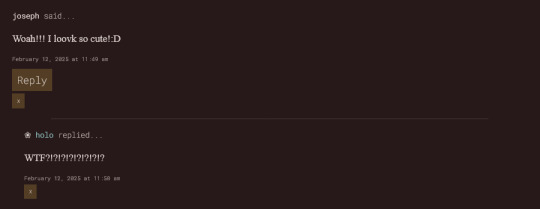
over on the side, I also went back and added a delete comment function too. accidentally had it earlier where if I tried to delete a reply it deleted the parent comment too. oops.
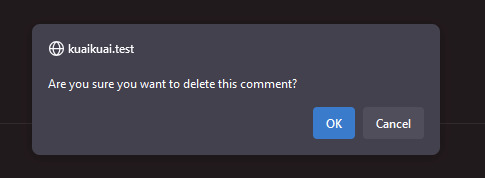
delete buttons (as well as the buttons that accept/reject comments on the user dashboard) had no confirmation so.. phew. now they do! I've accidentally deleted a whole years worth of art before on my computer, so I need this. very badly.
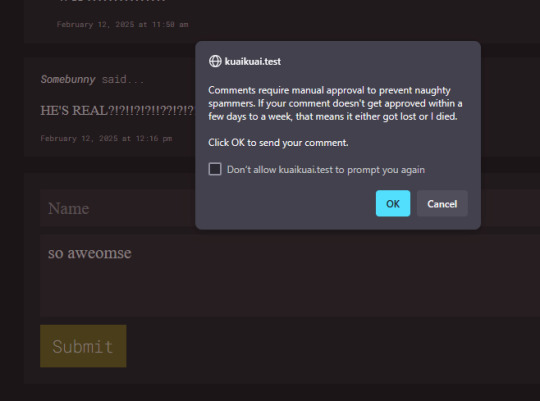
decided to move the warning into a confirmation alert once they hit submit. allows guests to see the warning in a less clunky manner, and also lets them know for sure that their comment is going to get sent! before the page would just refresh without any confirmation.. so this would be less confusing. two in one!
anyways, the next big feature I gotta implement is creating, editing, and deleting art. then I'll be done with all backend related things and I can finally start on the ~fun~ pages like my about. and other things.
unless I decide to make a guestbook. which I probably will end up doing..
I'll probably be keeping my neocities just for memory's sake and also to host my twine games and silly coding projects but I'll probably be removing my dreams page since I kind of don't want people seeing those anymore lest some tiktok-addicted teenager tries to kill me. better huff them all now if you want to peer into my sick twisted mind (jk I'm an angel)
2 notes
·
View notes
Text
#techsolutionstuff#laravel#laravel7#laravel 8#laravel6#php#jquery#javascript#disable#sorting#specific#columns#datatable#yajra datatable
0 notes
Text
#websolutionstuff#laravel#php#laravel7#laravel8#example#laravel6#jquery#datatable#yajra datatable#column#sorting#disable
0 notes
Link
With pagination, it is easier to display a huge list of data on the page.
You can create pagination with and without AJAX.
There are many jQuery plugins are available for adding pagination. One of them is DataTables.
In this tutorial, I show how you can add Datatables AJAX pagination without the Laravel package in Laravel 8.
#laravel#php#mvc#framework#datatables#pagination#jQuery#AJAX#MySQL#database#search#sort#coding#programming#web development#makitweb
0 notes
Text
Livewire for Laravel
Livewire is a full-stack framework for Laravel that makes building dynamic interfaces simple, without leaving the comfort of Laravel. — https://laravel-livewire.com/ This looks intriguing. The promise is a sort of shortcode powered ajax interaction for dynamic elements in web pages.
View On WordPress
0 notes
Link
Ecommerce web development services
We can see last seven to eight years, PHP opensource eCommerce platforms like WooCommerce, Magento, Joomla, etc., have utterly revolutionized the net looking business. Why? as a result of These platforms alter you to begin your eCommerce store though you do not have any expertise with eCommerce development as a result of they're terribly user friendly, straightforward to manage everything like sliders, categories, products, even managing orders area unit very easy whereas victimisation associate degree ASCII text file platform.
Dynamic:
PHP Open sources Ecommerce has associate degree simply manageable interface and merchandise with quite twelve ways of shipping if we've got contacted our shipping partner, twenty gateways for payment, and many gateways and shipping ways within the directory.
Security:
The fact that it's Ecommerce ASCII text file, and white-hat hackers will check its limits makes it less probably to be the target of a devastating attack. However, it's essential to know that code makes associate degree application vulnerable, not the language; thus, the developers should guarantee no breach opportunities. it's best for e-commerce solutions to source payments to a passionate supplier to avoid endangering your customers' accounts. In PHP-based websites, this is often potential through integration.
Cost-effective:
We know running a business is costly. you will not have an enormous enough budget – or any budget in the least – to make an internet store. Or, like the general public, we do not have the time to look for the most effective PHP frameworks. We'll ought to get hold of these plans eventually, however the free trial offers you the prospect to visualize if this is often worthy. ASCII text file PHP platforms area unit good for testing a platform and seeing if it'll be value paying for. A Best Ecommerce web development services company will guide you consequently on PHP opensource frameworks.
Advance and Faster:
PHP open supply is advanced and quicker as a result of the technologies and innovations employed in Magento and Laravel build your store performance quicker and safer and reliable than ever. In distinction, ASCII text file support all recent eCommerce and on-line business innovations like voice search, speed & performance enhancements, UI/UX, AI, and lean application footprint. The dev team introduces options like page builder, PWA integration, advanced coverage, extended cache support, and code automation.
Multiple Frameworks Available:
One of the foremost necessary why we tend to selected the PHP framework?
as a result of PHP has several works, Zend, Laravel, Symphony, CakePHP, Codeigniter, Yii, Phalcon, and PHPixie area unit simply many of the prevailing frameworks. every offers a mess of tools and modules, has professionals and cons, likewise as a whole community behind. Frameworks area unit nice since they provide the chance to recycle code. they are available with intrinsic functions for handling calendars, connecting to a information, operating with emails, and even debugging.
When selecting one for your e-commerce web site, it's essential to debate with the developer's potential requests that your web site has to serve and desired widgets, compatibility with third parties, and the other functions.
Themes, extensions, and Plugins:
One of the most effective reasons we tend to selected the PHP framework for eCommerce is that you just might want to get hold of things like themes and extensions. the great news is that Magento and WooCommerce just about go with all of the options you'd would like for a high-powered on-line store. However, a number of the themes area unit much better than others once you begin looking out on-line. you'll find yourself paying $1 for a subject, however you are presumably at an advantage trying to find one thing round the $100 vary.
Finally, the foremost costly a part of Magento is that you just might ought to rent a developer. If this is often the case, Magento most likely is not one amongst the foremost efficient ways in which to form an internet store. However, if you have got a partner who's a developer, otherwise you have development expertise yourself, you will not ought to notice a freelancer or a regular worker to run the web site for you. in this state of affairs, Magento is one amongst the most effective values for building an internet store.
More options of Ecommerce:
Slick, elegant, fast, and SEO friendly.
Add members as several as you would like.
Create unlimited groups with three totally different layouts (Carousel, Grid, and List).
Highly customizable with colours and stylings.
Different team members input fields like name, position, photo, short bio, social links, etc.
Control columns in numerous devices.
Multiple image size choices.
Image rivet and Out result
10+ Carousel controls
Cross-browser supported.
Multi-site supported
And many additional choices
Due to the increasing demand for Commerce, the event of PHP members has several steps to follow up as a result of on-line looking is changing into progressively fashionable for numerous reasons.
There area unit actually outside factors like increasing gas costs, problem in
getting to ancient stores and hassles usually related to looking malls and
other ancient stores to contribute to the magnified interest in on-line looking.
Consumers will get full data concerning the merchandise with its reviews being gone along the prevailing users. If one desires to shop for a product, he/she isn't any longer
limited to asking the chums and families as a result of there area unit several product reviews
on the web, which supplies opinions of the prevailing users of the merchandise.
Online looking sites contain a good sort of product, each top quality and
mild quality, keeping in mind the extent of individuals.
PHP eCommerce is extremely a lot of productive for on-line traveling websites; consistent with merchandiser in 2007, concerning forty two million U.S. Households engaged travel on-line. A Nov 2006 survey found that just about sixty p.c of these polled within the u. s. aforesaid they used the net to set up a vacation. By 2010, Online
Travel Booking revenues area unit expected to grow concerning $146 billion from 2007 to $ ninety four
Billion, currently in West Pakistan peoples area unit educated day by day. they're victimisation everything on-line; albeit they're victimisation rides online through Uber and Careem, Food panda services area unit notable for metropolis and Pakistan's on-line food delivery.
#new post#tumblr#ecommerce#Ecommerce web development services#Online store development services in Karachi#Ecommerce website development in Karachi#Ecommerce services in Karachi#Ecommerce development Company In Karachi#inspiration
2 notes
·
View notes